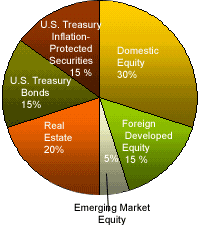I started reading Swensen's book "Unconventional Success, A Fundamental Approach to Personal Investment" a couple of weeks ago. I have to take little bites and chew slowly, and it doesn't help that I read just before going to bed when I am already drowsy. I am just into the first part, where he is distinguishing between Core Asset Classes and Non-Core ones.
From the book:
"Core asset classes share a number of critical characteristics. First, core asset classes contribute basic, valuable, differentiable characteristics to an investment portfolio. Second, core holdings rely fundamentally on market-generated returns, not on active management of portfolios. Third, core asset classes derive from broad, deep, investable markets."
He includes in core asset classes:
- Domestic equities, foreign developed market equities, emerging market equities: "drive portfolio returns"
- U.S. Treasury bonds: "promise protection from financial catastrophe"; and U.S. TIPS: "provide ironclad assurance against inflation-induced asset erosion." These are used for diversification.
- Equity Real Estate: "produces a hybrid of equity-like and bond-like attributes, generating inflation protection at a lower opportunity cost than other alternatives".
Non-core asset classes are those that fail to meet at least one of the criteria for core asset classes. I am just starting on this portion, but I see that he lists:
Domestic Corporate Bonds, High-Yield Bonds, Tax-Exempt Bonds, Asset-Backed Securities, Foreign Bonds, Leveraged Buyouts, Venture Capital partnerships.
He goes into discussion of these non-core assets just as he did for the core ones, describing asset returns and risks, market characteristics, alignment of interests between the investor and the issuers of the asset class, etc. I took a peek at the chapter summary and this is what he says:
"Non-core asset classes provide investors with a broad range of superficially appealing but ultimately performance-damaging investment alternatives. A host of fixed-income markets fall short of the diversifying power inherent in the default-free, full-faith-and-credit obligations of the U.S. government..."
Note that his "outline of a well-diversified, equity-oriented portfolio" (see pie chart posted by OP) uses only what he defines as core asset classes.
I'm not a sophisticated investor and I do not understand well how bonds work. (I understand bonds and the bond market even less than equities). I have a little allocation in bonds:
7.6 % in I-Bonds
2.6% in a Total Bond Market Fund in my Deferred Comp plan
2.5% in Vanguard's High-Yield Corp Bond Fund in my Rollover IRA
(I am another of those with the teeny asset class percentages laughable to some, but I have just begun with these last two funds.)
I don't put in as much into bonds because I look at my returns from them and see how low they are compared to equities. Another reason for hesitation is not internalizing the role of diversification that they play in my portfolio. I do plan to shift more into bonds fixed-income assets as I near retirement, and I think I will go with some US Treasuries and TIPS rather than corporate bonds.
Having seen previous discussions about CPI not being "realistic" and measured by the same body that pays out on TIPS, I don't fully believe the "iron-clad assurance" against inflation erosion used by Swensen to describe TIPS. I will try to also reach maybe a 10%-15% allocation of stable (mostly blue-chip), dividend-paying stocks that have dividends around 4%.
From the little I've read so far, Swensen's book seems to be a good primer for new or unsophisticated investors (like me).
Edited to provide full title of book and then to correct from "bonds" to "fixed-income assets"
